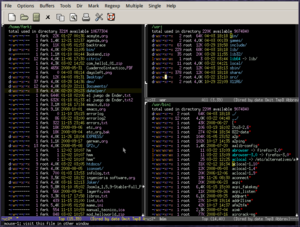Emacs pinky

|
|
| Developer(s) | David A. Moon, Guy L. Steele, Jr. |
|---|---|
| Initial release | 1976 |
| Written in | Lisp, C |
| Operating system | TECO, cross-platform, Unix-like |
| Type | Text editor |
| Website | www |
Emacs /ˈiːmæks/ and its derivatives are a family of text editors that are characterized by their extensibility. The manual for the most widely used variant, GNU Emacs, describes it as "the extensible, customizable, self-documenting, real-time display editor". Development of the first Emacs began in the mid-1970s and continues actively as of 2017[update].
Emacs has over 2,000 built-in commands and allows the user to combine these commands into macros to automate work. Emacs Lisp provides a deep extension capability allowing users and developers to write new commands using a dialect of the Lisp programming language. Extensions have been written to manage email, files, outlines, and RSS feeds.
The original EMACS was written in 1976 by David A. Moon and Guy L. Steele, Jr. as a set of Editor MACroS for the TECO editor. It was inspired by the ideas of the TECO-macro editors TECMAC and TMACS.
The most popular, and most ported, version of Emacs is GNU Emacs, which was created by Richard Stallman for the GNU Project.XEmacs is a variant that branched from GNU Emacs in 1991. Both GNU Emacs and XEmacs use Emacs Lisp and are for the most part compatible with each other.
...
Wikipedia
